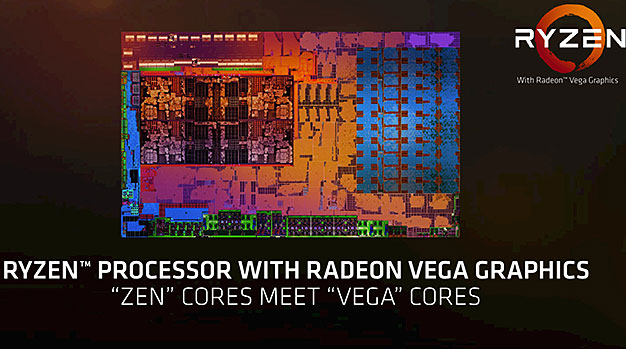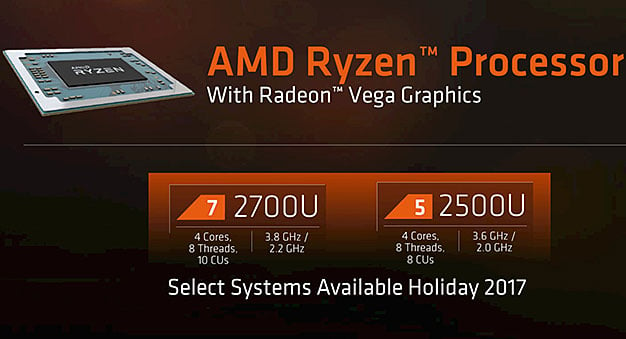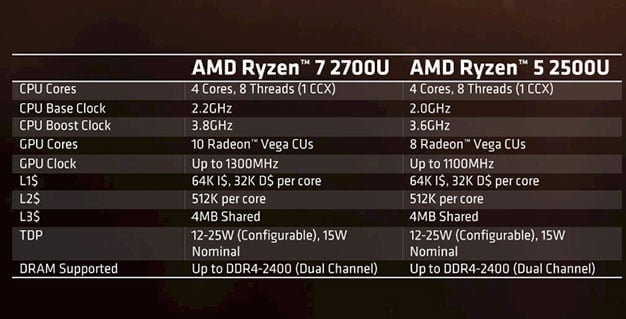AMD Launches Ryzen Mobile Combining Zen And Vega To Take On Intel In Powerhouse Laptops
AMD Ryzen Mobile Goes Toe-To-Toe With Intel's Kaby Lake R
There are two initial chips in the processor family that AMD is announcing today: the Ryzen 5 2500U and the Ryzen 7 2700U. Both processors feature four cores capable of executing 8 threads with SMT. However, there are differences with respect to processor clocks and GPU specifications. AMD's Ryzen 5 2500U has a base clock of 2GHz and a boost clock of 3.6GHz, while Ryzen 7 2700U tacks on 200MHz to both of those figures. In addition, the Ryzen 5 2500U features 8 Radeon Vega CUs (Compute Units) and a GPU clock of 1.1GHz, compared to 10 Radeon Vega CUs and a GPU clock of 1.3GHz for the higher-end Ryzen 7 2700U.
AMD is making rather ambitious claims for the new processors, and promises some pretty impressive gains over its 7th generation Bristol Ridge predecessors. According to AMD, CPU and GPU performance will see 200 percent and 128 percent uplifts, respectively.
Even more impressively perhaps, power consumption has been reduced by 58 percent with these new processors, which is critical in the mobile segment, where battery life is often on equal priority footing for many mainstream users.Common to AMD's Zen desktop architecture, you'll find SenseMI technology coursing through these new Ryzen Mobile processors as well. However, what's new with Ryzen Mobile is Precision Boost 2 and Mobile Extended Frequency Range (mXFR). The former can adjust the CPU clock speed in 25MHz increments, and now uses an opportunistic algorithm that adjusts frequencies on a per-core basis using a number of variables (CPU temperature, current, and load). The latter brings XFR to AMD's mobile product offering by raising sustained clock speeds on notebooks that have been designed to accommodate the increased load with better thermal capacity. As you can see in the chart below, a Ryzen 7 2700U with mXFR enabled is able to achieve nearly 25 percent greater performance in Cinebench nT compared to the same processor with mXFR disabled.
Of course, all of the specs and special features sound nice, but how does it all stack up when it comes to performance; especially when compared to what Intel offers with its 7th generation Kaby Lake and 8th generation Kaby Lake R processors? Even taking into account that these numbers are coming straight from AMD and we haven't had a chance to test out silicon in our labs here, general CPU performance looks to be in the same ballpark or notably ahead of Intel in most benchmarks in multi-threaded workloads. Again, these aren't our numbers so digest them with a grain, as they say...
Looking strictly at CPU performance, using the AMD FX-9800P as a baseline, the Ryzen 7 2700U and Ryzen 5 2500U simply trounce that legacy processor. In POVRay 3.7, PCMark 10 Extended, and TryeCrypt 7.1a, both Ryzen Mobile processors also manage to outgun the Intel Core i7-8550U Kaby Lake R quad-core. The Intel chip does take the gold, however, in PassMark 9, if only by a small margin. Intel scores another small victory in the Cinebench R15 1T benchmark with both the Core i7-8550U and the Core i7-7500U, but AMD returns the favor by demolishing both in Cinebench R15 nT multi-threaded workloads.
What everyone wants to know of course is how the Vega graphics core inside these new APUs fair against Intel's integrated HD Graphics engines, as well as low-end discrete competition from NVIDIA. In 3DMark Time Spy, the AMD Ryzen 7 2700U leaves the Intel IGPs (and the FX-9800P) in the dust, while offering performance on par with that of a GeForce GTX 950M, when combined with a dual-core Kaby Lake CPU (not Kaby Lake R).
But we have to remember that this is still a heavily downsized version of Vega that has been optimized for mobile power envelopes. Even in its most potent form, the GPU in these Ryzen Mobile processors has a max clock speed of 1.3GHz and just 10 Vega CUs. For comparison, the mid-range Radeon RX Vega 56 desktop graphics card has a boost clock of 1.471GHz and 56 CUs. As you can see by the benchmarks above, that means that you'll be gaming at 720p or 1080p resolution, with League of Legends approaching 60fps at 1080p on Medium quality settings, while Quake Champions just barely cracks the 40fps barrier at 720p with High quality settings. Still, not too shabby at all for integrated graphics.
The bottom line is, Vega represents a huge generational leap compared to where AMD was last year, but don't expect any performance miracles compared to discrete solutions from NVIDIA in the mobile space. However, it should be underscored that compared to Intel integrated HD Graphics, Ryzen Mobile should handily dust Intel's finest mobile chips in gaming workloads.
AMD has designed the new Ryzen Mobile processors to go in thin and light notebooks, and the first of these products will begin shipping later this quarter (Q4 2017). The first three models available will come from familiar names in the PC business: Acer, Hewlett-Packard and Lenovo.
In short, AMD looks to have a potent, credible threat on its hands with Ryzen Mobile versus Intel, and the company could very well shakeup the mainstream laptop market like it did in the desktop sector. The new processors appear to offer highly competitive multi-threaded performance to Intel's 8th generation quad-core/8-thread Kaby Lake Refresh processors, while delivering significantly greater graphics performance. If you're in the market for a notebook at entry-level to mid-range pricing, solutions based on AMD Ryzen Mobile look like good candidates to be on your shopping list here in the Q4 holiday season.




















